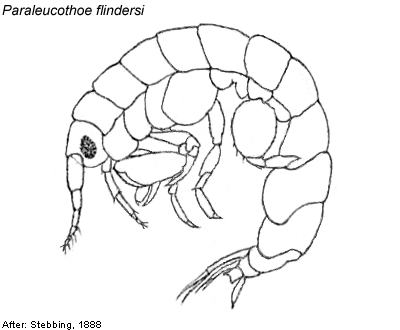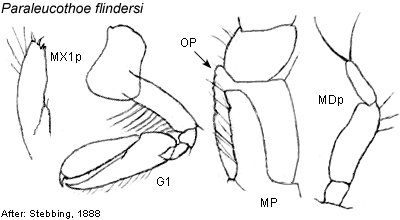 |
||||||
|
|
|
|
|
|
Australian Amphipoda: LeucothoidaeJ.K. Lowry, P.B Berents & R.T. Springthorpe
Paraleucothoe flindersi (Stebbing) Leucothoe flindersi Stebbing, 1888: 779, pl. 48. --J.L. Barnard, 1972:. Type material. HOLOTYPE: sex unknown, 2.5 mm, ? BMNH. Type locality. Flinders Passage, Torres Strait, 16 m depth (10º30'S 142º18'E). Description. Based on Stebbing, 1888: 779, pl. 48. Head lateral cephalic lobe without cusp; cephalic keel present; rostrum small to medium in size. Antenna 2 slender. Mandibles and maxillae well developed; mandibular palp 3-articulate. Maxilla 1 palp 1-articulate. Maxilliped ischial endite (outer plate) vestigial or absent, without lateral flange. Peraeon. Gnathopod 1 coxa large, not hidden by coxa 2, anteroventral corner produced, anteroventral corner broadly rounded; dactylus vestigial. Gnathopod 2 coxa at least as long as broad, rounded anteroventrally; carpus with simple apex; propodus palm convex, propodus palm weakly crenulate or smooth along entire margin; dactylus, inner margin smooth. Peraeopod 3 coxa longer than broad, anteroventral corner overriding lateral face of coxa 2, not extending freely below it, ventral margin slightly convex. Peraeopod 4 coxa, posterior margin with posteroventral lobe. Peraeopods 5 to 7 basis expanded. Pleon. Epimeron 3 posteroventral corner broadly rounded. Habitat. Marine. Depth zone. Littoral. Remarks. J.L. Barnard (1972) considered P. flindersi to be distinct from P. novaehollandiae. Paraleucothoe flindersi differs from P. novaehollandiae in not having a well developed outer plate or a lateral flange on the ischium of the maxilliped, in having the anteroventral corner of coxa 1 produced, a weak to smooth margin on the palm of gnathopod 2 and a broadly rounded posteroventral corner on epimeron 3. Distribution. Queensland: Flinders Passage, Torres Strait (Stebbing, 1888). Geographic areas. North-eastern Australia.
Cite this publication as: Lowry, J.K. P.B Berents & R.T. Springthorpe (2000 onwards). 'Australian Amphipoda: Leucothoidae.' Version: 2 October 2000. https://crustacea.net/'. |
|
|
|
|
|
|
|
|
|
Copyright © Australian Museum, 2021
Australian Museum website

